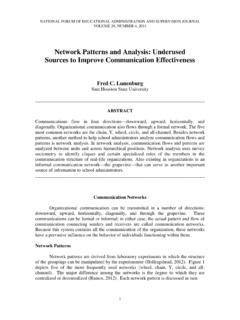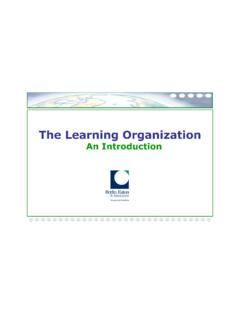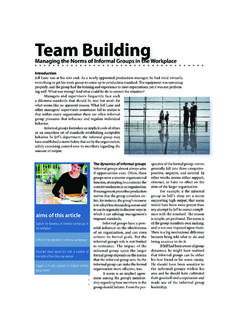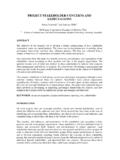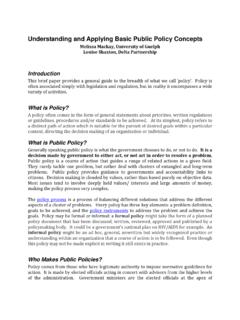Transcription of Workplace Communication: A case study on …
1 1 Workplace communication : a case study on informal communication network within an organization Evangelos Ergen, Issue date: 26 November 2010 Abstract: This paper is an attempt to bring forth, analyse and compare different aspects in terms of Workplace communication . It focuses in the informal communication which considered a significant factor for an organization s internal and external progress. It is a study on literature, which aims to link the literature findings with a real case of a company which seeks to improve its Workplace communication . In the end, it proposes certain strategies to be followed in order to control and affect the existed informal communications network . Thus, cultivation of Communities of Practice and Face-to Face contacts are expected to influence and turn the informal network to an added-value for the organization . Keywords: communication , informal and formal communication , Workplace communication , face-to-face contact, Communities of Practice (CoPs).
2 1. INTRODUCTION Forty years ago, James Granger (1970) described a number of obstacles that companies faced in order to gain an effective communication . He identified: the existence of fear among employees; the inertia due to a non-rewarding system; the sense that management did not care about their problems; the fear that disagreement will block their promotions; and the lack of supervisory accessibility and responsiveness. To cope with that, Granger claimed that companies should take three actions, in order to change radically the environment: (a) the management should start building trust between them and employees; (b) the management should put a premium on integrity; and, (c) they should get out of their offices and find out what s going on, in their organization . Over the years, different studies concluded that top management is necessary to build the right infrastructure of communication within the organization .
3 When an organization grows, it is easier to be entrapped in a complicated system of communicating. Opposing to this, practices such as: honesty; integrity; and reward; create trust among employees. Workplace communication is definitely affected by the infrastructure of the organization , but this is not the only parameter. The second section of this paper -the literature review- relates to the Workplace communication with emphasis in informal communication network within the organization . The review includes an extended survey on communication and communication process, communication channels and barriers of communication . Different aspects are presented through comparisons of academic studies, theories synthesis and discussion of findings. The third section describes a real case of an organization regarding its Workplace communication . Based on literature review, recommendations are given in how to improve current communication s framework through the control and affection of the existed informal communication network .
4 2. LITERATURE REVIEW communication and communication process According to Scott (2005), communication is about sending, receiving, and understanding information and meaning. He claimed that receiving and understanding are the most important operations in the communication process, since the response of the receiver defines whether the communication attempt is successful or not. He further defined two types of communication that are related to Workplace communication ; the effective and the efficient communication (Scott, 2005). Effective communication , when the message of the sender has a successful decoding from the receiver; and efficient, when the communication is done effectively at a low cost. 2 Furthermore Guo and Sanchez (2005), defined communication , as the creation or exchange of thoughts, ideas, emotions and understanding between sender(s) and receiver(s). They found a strong relationship among communication and the efficient and effective performance of the organization .
5 communication process is the procedure where a sender and a receiver communicate. This scheme incorporates the encoding-decoding operations and describes the usual transfer of the message. McShane and Von Glinow (2003) have illustrated this process by adding the feedback and communication barriers: Figure 1. The communication Process (Source: McShane, and Von Glinow, (2003) Organizational Behavior: Emerging realities for the Workplace revolution. 2nd edition. Boston, McGraw-Hill, p. 324.) In communication process, feedback is considered an indispensable component, since it contributes correctively to the new inputs of information, or even works towards the adjustment of sender and receiver. As Guo and Sanchez (2005) asserted, lack of feedback corresponds to one-way communication , where there is no possibility of response. On the contrary, two-way communication is more accurate and information-rich.
6 To this extent, combining with Scott s findings, the adoption of two-way communication , could direct an organization to effective and efficient communication . communication Channels These are the ways that messages and information travel around such as: (a) the verbal communication , (b) the non-verbal communication and (c) the technology-aided communication , which accommodates e-mailing, instant messaging, micro-blogging, ontology, and communities of practice. Verbal communication is considered the spoken and written modes. Non-verbal communication on the other hand, is the communication that transcends the written or spoken word (Gabbott and Hogg 2001). Gabbott and Hogg (2001) identified that non-verbal communication channels incorporates much more complex aspects, and grouped them into 4 categories: 3 Figure 2. Non-verbal communication Different surveys have shown that non-verbal communication channels covers the 70% or even the 90% of Workplace communication (Dumbrava and Koronka, 2009; Gabbott and Hogg, 2001).
7 In addition, Butkeviciene et al. (2008) highlighted the importance of use of non-verbal components for business purposes as they have greater impact. The impact and reliability of non-verbal communication is higher than the spoken word, but it is conditioned to proper interpretation and the ability to place it effectively in a framework of wide communication which includes other channels as well. Besides that, the introduction of technology in Workplace communication , as well as, the high levels of penetration in the globalised markets, created the essence of effective collaboration. For example Whittaker and Bradner (2000), introduced the terms of interaction and outeraction. Interaction is exchanging information , while outeraction means stay connected to coordinate impromptu meetings. The components of computer-aided communication such as instant messaging, e-mailing, groupware, phone, other social computing tools etc.
8 , have altered the communication process by providing flexibility, better informed-employees, more accurate decision making and finally by changing the organization structure of the company. Companies that have cultivated a technology-friendly environment in terms of communication have achieved a more competitive position in the fast-changing business environment (Lau et al., 2001). Micro-blogs, a new technology in broadcasting messages and information, according to Zhao and Rosson (2004), contributed in (a) the enhancement of information sharing, (b) the build of common ground for the participants and (c) the sustainment of the feeling of connectedness among colleagues. Another research by Kurokawa (2007), introduced the mechanism-protocol of ontology for cross-organizational communication , a fundamental tool for communication , which combines the organization -to- organization communication where colleagues from different areas or even companies could share information in a mutually understandable way.
9 Nevertheless Randall (2010) argues that technology by itself cannot replace the social aspect, which face-to-face or similar type contacts, enable among colleagues. Any conflicts, misunderstandings or issues that stay unresolved, can be handled with a combination of proper use of communication means. Barriers to communication communication barriers are considered anything that filters, blocks or distorts the message or the information during the process of encoding-sending-decoding . Longest et al. (2000), classified the communication barriers in two categories: environmental and personal. They have presented a relevant framework (Appendix A) which categorises the barriers and proposes positive actions to overcome them. Guo and Sanchez (2005) described as environmental barriers the characteristics of the organization that derive from its environmental setting. As personal barriers they defined 4 anything that arises from the nature of individuals and their interaction with others.
10 According to Smith (2002), Workplace communication barriers are depended on the company s infrastructure. As it seems, before Guo and Sanchez, Smith connected the effective communication with the built-in communication systems of the organization , actually implying the relation between potential barriers and company s environment. She claimed that inadequate communication systems result in miscommunication and missed communication (Smith, 2002). Similarly, Anand and Shachar (2007) identified that a focal attribute of communication is miscommunication. However, miscommunication could be avoided if right mechanisms are applied. Such mechanisms involve (a) greater focus to be given in the perception of the message or information which is about to be sent, and (b) to try to improve the precision of the message. At this point, Marks (2009) noted that personal visits, face-to-face communication , speaking a common language, increase credibility and improve communication , tearing down barriers.

